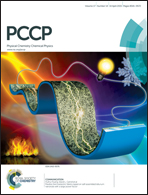Investigation of electron density changes at the onset of a chemical reaction using the state-specific dual descriptor from conceptual density functional theory
Abstract
The electron density changes from reactants towards the transition state of a chemical reaction is expressed as a linear combination of the state-specific dual descriptors (SSDD) of the corresponding reactant complexes. Consequently, the SSDD can be expected to bear important resemblance to the so-called natural orbitals for chemical valence (NOCV), introduced as the orbitals that diagonalize the deformation density matrix of interacting molecules. This agreement is shown for three case studies: the complexation of a Lewis acid with a Lewis base, a SN2 nucleophilic substitution reaction and a Diels–Alder cycloaddition reaction. As such, the SSDD computed for reactant complexes are shown to provide important information about charge transfer interactions during a chemical reaction.


 Please wait while we load your content...
Please wait while we load your content...